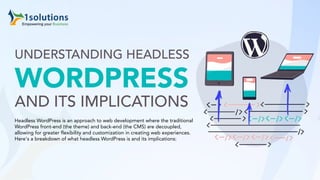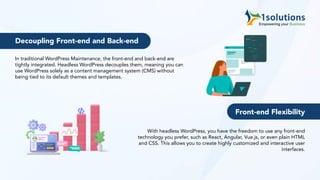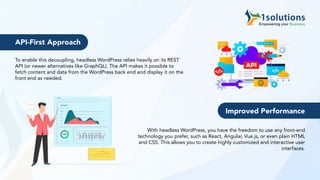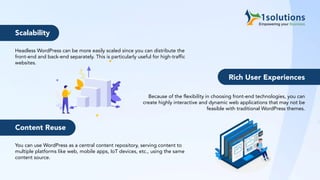Understanding Headless WordPress and Its Implications.pdf
- 1. UNDERSTANDING HEADLESS WORDPRESS AND ITS IMPLICATIONS Headless WordPress is an approach to web development where the traditional WordPress front-end (the theme) and back-end (the CMS) are decoupled, allowing for greater flexibility and customization in creating web experiences. Here's a breakdown of what headless WordPress is and its implications:
- 2. Decoupling Front-end and Back-end Front-end Flexibility In traditional WordPress Maintenance, the front-end and back-end are tightly integrated. Headless WordPress decouples them, meaning you can use WordPress solely as a content management system (CMS) without being tied to its default themes and templates. With headless WordPress, you have the freedom to use any front-end technology you prefer, such as React, Angular, Vue.js, or even plain HTML and CSS. This allows you to create highly customized and interactive user interfaces.
- 3. API-First Approach Improved Performance To enable this decoupling, headless WordPress relies heavily on its REST API (or newer alternatives like GraphQL). The API makes it possible to fetch content and data from the WordPress back end and display it on the front end as needed. With headless WordPress, you have the freedom to use any front-end technology you prefer, such as React, Angular, Vue.js, or even plain HTML and CSS. This allows you to create highly customized and interactive user interfaces.
- 4. Scalability Rich User Experiences Headless WordPress can be more easily scaled since you can distribute the front-end and back-end separately. This is particularly useful for high-traffic websites. Content Reuse You can use WordPress as a central content repository, serving content to multiple platforms like web, mobile apps, IoT devices, etc., using the same content source. Because of the flexibility in choosing front-end technologies, you can create highly interactive and dynamic web applications that may not be feasible with traditional WordPress themes.
- 5. Development Complexity Customization While headless WordPress offers great flexibility, it can be more complex to set up and maintain compared to a traditional WordPress site. You may need developers with expertise in both WordPress and your chosen front-end technology. Customizing the front end requires more development effort, which could mean higher costs. However, it also means you have complete control over the user experience. IMPLICATIONS
- 6. Content Management Plugin Compatibility Content management may become slightly more complex since it's no longer tightly integrated with the theme. You may need to use plugins or custom solutions to manage content effectively. Some WordPress plugins may not work seamlessly in a headless setup, so you'll need to carefully evaluate and choose plugins that align with your architecture. Remember, headless WordPress is a powerful approach that provides flexibility, performance benefits, and the ability to create modern web experiences. However, it's best suited for projects where customization and performance optimization are critical, and you have the development expertise to implement and maintain the architecture effectively.
- 7. WANT TO INVEST IN WORDPRESS SUPPORT SERVICES www.1solutions.biz +1 (323) 455 4564 info@1solutions.biz CONNECT WITH US







